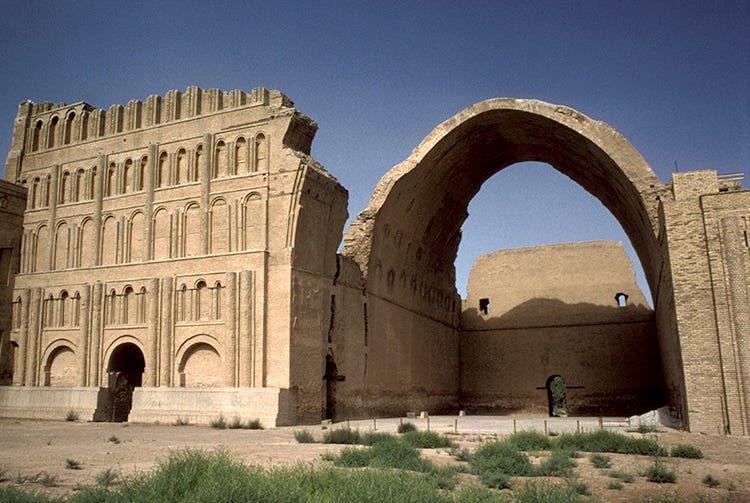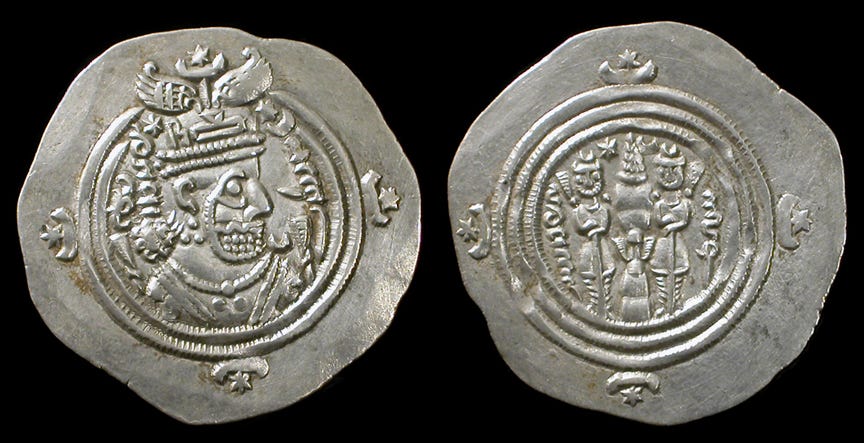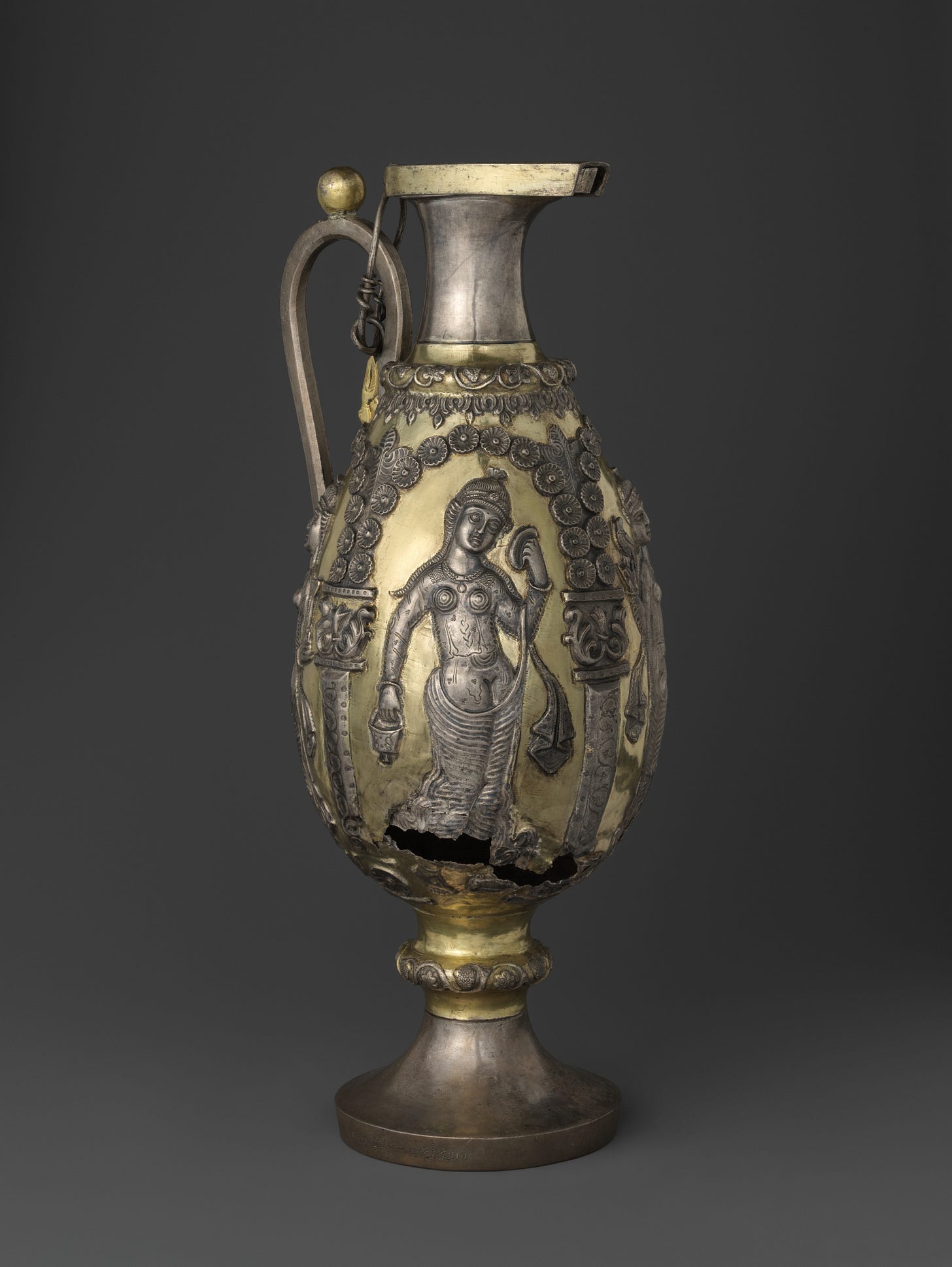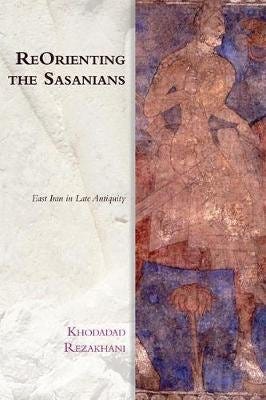ReOrienting the Sasanians
A little book about big things (with a hidden bonus feature!)
Hello and happy Friday!
I hope you’ve had a good week and especially if you’re in the southwestern USA, that you and yours are safe and well.
This week has been pretty fun in History land. (Other parts of life have been pretty chaotic but that is exactly what a cup of coffee and a multi-millennial perspective is for!)
Carving out time to read has always been a challenge: I binge and then get out of the habit for a while, so setting aside 15 minutes a day just to read something that isn’t ‘necessary’ for a particular project over the last few months has been wonderful. One of the first books I chose had been on my shelf for a while:
Rezakhani, Khodadad, ReOrienting the Sasanians: East Iran in Late Antiquity, Edinburgh Studies in Ancient Persia (Edinburgh University Press, 2017)
I talked last week about how the title for this book and the challenge of talking about things that are way outside the history we get taught in school and in everyday life. This week, I want to talk about the book itself (because it’s great!).
The Sasanians
Let’s start with a bit of a recap!

The Sasanian Empire was one of the biggest and most powerful empires of the ancient/early medieval world. Between 224 and the middle of the seventh century they ruled over the areas of modern Iran and Iraq but also, at times, the Caucasus (modern Armenia and Georgia), areas of Central Asia and northern South Asia (parts of modern Pakistan and India). Briefly, in the seventh century, they conquered the Levant all the way to the Mediterranean and Egypt.
Most often, the Sasanians are known as the greatest rival of the Roman Empire but recent research has emphasised that they were much more than that.
There are challenges to seeing the Sassanians on their own terms though. They probably produced fewer written sources than the Roman Empire and definitely fewer written sources survive. Archaeological excavation has also not been as extensive. (In fairness, nowhere has had as much archaeological investigation as the Roman Empire!)

Luckily, they did produce a lot of coins! Numismatics has been central to reconstructing Sasanian history. We also have seals, probably pressed onto letters or products, for example to show that things had been bagged up into packages of the correct weight and checked by a suitable official.

Sasanian art influenced the development of West Asian traditions for centuries. The surviving objects we have give us an insight into style and things the rich liked (mainly hunting, fighting and women, so not everything is surprising).

These days, there are some decent, clear summary histories: no mean feat considering how much work it took just to put together a list of which Shah (emperor) came after which.1 They mainly focus on the western capital of the empire, in Ctesiphon (near Baghdad) and mainly on war and diplomacy with the Roman Empire.
But what if a huge part of that story was missing and what if, because of that, the whole picture was wonky?
Khodadad Rezakhani’s aim in ReOrienting the Sasanians is to put the eastern parts of the empire back into the picture but sometimes, before you can solve one problem, you have to solve a few others.

To fit East Iran back into the history of the Sasanians, Khodadad therefore sets out to do something very new: to write a continuous, political history of the region itself, before during and immediately after the different times when it was Sasanian or connected with the Sasanians.
As I discussed last week, this involves piecing together stories from different kinds of evidence and wading through debates that can seem tiny and insignificant from inside (is the third letter on that coin an a or a u?!) but which can have huge implications.
As Khodadad begins by explaining, the eastern territories of the Sasanian Empire and the places just beyond them, from the 8th century onwards, would be a political and cultural powerhouse. Khurasan (or Chorasan, or a couple of other spellings besides), as a part of the later medieval world of Islam, produced political revolutions that shook the world from the Himalaya to the Straits of Gibraltar. It was where 11th-century poet, Ferdowsi (alternatively, Firdausi), wrote the incredible Persian-language epic, the Shahnameh or Book of Kings.2
In earlier centuries, this region and its component parts have had many names and have been called many since: Khwarazm (the origin of Khurasan), Transoxiana, Tokharistan, Zabulistan, Sistan, Kabulistan... The catch-all, ‘Central Asia’, however, extends much further, into places that were politically and culturally distinct.
That’s why Khodadad introduces the idea of ‘East Iran’. Politics and history are never separable and he addresses directly the possible accusation of cultural colonialism, linked with the modern government of the Islamic Republic of Iran. The roots of the term ‘Iran’ (or, under the Sasanians, Ēran) are much deeper, though. It is a word that has expressed overlapping cultural, linguistic, religious and political similarities for millennia. This is the meaning Khodadad invokes.
After that, in a book ostensibly about the Sasanians, the Sasanians themselves drop in and out of the narrative. That is fitting, as they dropped in and out of parts of this huge area. They were sometimes present as direct political rulers. They also shared the stage with others: the Sasanians might appoint local rulers as ‘satraps’ or deputies to manage affairs for them; at other times, local rulers might break away and establish themselves against the Sasanians, but often using Sasanian imagery, titles and rituals to convey their own power.
Words like ‘imitation’ miss the complexity of these processes, which Khodadad puts into full focus: does it mean the same when two different political leaders issue coins with rulers on them that look stylistically similar to a Sasanian Shah, but with slightly different facial features, language or design?

Obviously not, right? But it is invaluable to have a book thats sets out the difference between a local ruler appropriating Sasanian imagery too assert their independent political power against the Sasanians and a leader after the Sasanians had been overtaken by the Muslim conquests using Sasanian imagery to stake a unique cultural and political claim in a rapidly changing landscape.
In short, there is tonnes of good stuff in here, including plenty of pictures, and a political narrative that didn’t really exist for this period and region before.
But I mentioned a hidden bonus. (Everybody likes an unexpected prize!)
This book is
…drum roll…
the most up-to-date, accessible and coherent political history in English of the Kushan Empire
Cue fireworks and a choir of nerdy angels!!
Thank God! I hear you cry…
No?
Fair.
Last week I said that this book wasn’t quite what I expected from the title. I talked about the challenge when what you do is sufficiently obscure that there isn’t necessarily an obvious pitch line.
The fact that this is such a fantastic book about the Kushans was what surprised me but by the end, I got it.
Sure, you could call a book A Brief Introduction to the World of the Kushans, but then a whole bunch of other people (like Sasanianists and Romanists, who at least see the relevance of each other’s stuff to one another but may not go beyond that) probably wouldn’t read it because it often doesn’t seem obvious how the Kushan’s fit into that picture (if they are on the radar at all).3
That’s why I’m all in favour of this undercover Kushan precision-strike, perfectly executed and beautifully landed. At the end of this book, Khodadad makes a case that would be no surprise at all to a Kushan specialist (but that isn’t a very big constituency). To everybody else, it isn’t necessarily obvious at all:
In the ancient world of the first and second centuries, the Kushan Empire was a major imperial power, a gravitational well around which smaller political organisations emerged from the first century BCE onwards; a source of imagery and codes of power far beyond their borders and for centuries after their maximum influence (in the 1st century BCE to the 4th century CE).
Khodadad shows that the Sasanians were profoundly influenced by the Kushans in how they presented themselves through imperial titles and images and that defeating the Kushans in their Central Asian territories was a massive deal in the Sasanians proclaiming themselves as a regional superpower in the 3rd century.
Just as the Romans continued to be a rival and potential threat on the Sasanians’ western border, so the Kushans were on their southeastern frontier. Even if this was usually not such a ‘hot’ border, mainly because of the sheer physical obstacle of the Himalaya, it shaped Sasanian self-definition as rival to two great world powers and controller of what had once been ‘Kushanshah’, the realm of the Great Kushans.
If we’re looking to change our picture of the world, it isn’t enough simply to colour in the edges around the spots we already know well. We need to change the shapes we’re colouring in.
This is something Khodadad’s book does brilliantly: by the end of it, concentration of political power in ancient Eurasia is no longer a rectangle, with the Roman Empire at one end and the Han Empire at the other. It is a triangle, with the Great Kushans sitting in the middle, providing another possible ally, enemy and inspiration.

If you like your history reading like a Ferrari, with strong, direct lines and the inner workings packed inside a bright red “Ka-pow” shell, history that takes you on one hell of a ride and leaves you wondering when you finish how the world even looked before you started, this probably won’t be the book for you. Those kinds of histories are amazing (I hope one day I can write one, or at least a yellow Lexus of a book), but there are good reasons why that isn’t possible for East Iran.
If that is you, take my word for what I’ve summarised here and join the reimagining of the ancient world! Look out for the Kushans when you come across them (even knowing they are unfamiliar, museums often can’t resist displaying Kushan coins because they are so stunning). When you read about ancient empires go ahead and feel a big smug as you find yourself wondering, but dude, what about the Kushans?4
If you like your history reading like a Landrover, though: a bit more rumbly and rugged, with the parts all where you can see how they go together, or you’re just wild about getting off the beaten track, I strongly recommend this book. It is fairly short, extremely lucid (especially considering the difficulties of the evidence), and beautiful at taking you by the hand and leading you through the weird and wonderful expert parlous parties that Khodadad has decoded for your convenience.
And whatever you choose, if you can, take that 15 minutes, open a book (or slip on some headphones) and give your brain a daily wander.
I’ll tell you about my next read when I’m through it, but no deadlines: the point is the journey!
I would suggest any of: Sarkhosh Curtis, Vesta, and Sarah Stewart, eds., The Sasanian Era, The Idea of Iran, 3 (I.B. Tauris in association with The London Middle East Institute at SOAS and The British Museum, 2008), with a focus on art and objects; Sauer, Eberhard W., ed., Sasanian Persia: Between Rome and the Steppes of Eurasia, Edinburgh Studies in Ancient Persia (Edinburgh University Press, 2017) for probably the best fairly accessible and focussed study and Wiesehöfer, Josef, Ancient Persia: From 550 BC to 650 AD, trans. by Azizeh Azodi (Tauris, 2001) for a longer perspective. Oh, and Khodadad’s book, obvs!
Most definitely on my ‘read this, read this, read this!’ list. Dick Davis’s Penguin translation is beautifully readable and captures why this is one of the epics of the ages. Oh, and there’s also a giant talking bird.
I’m not criticising anybody’s reading choices here: there are so many publications coming out every year, especially about anything to do with the Romans, but even about the Sasanians, that we’re all running triage.
As those of you I have taught will testify, I used dude long before and after it got cool (second time around) and consider it a genderless vocative exclamation.


